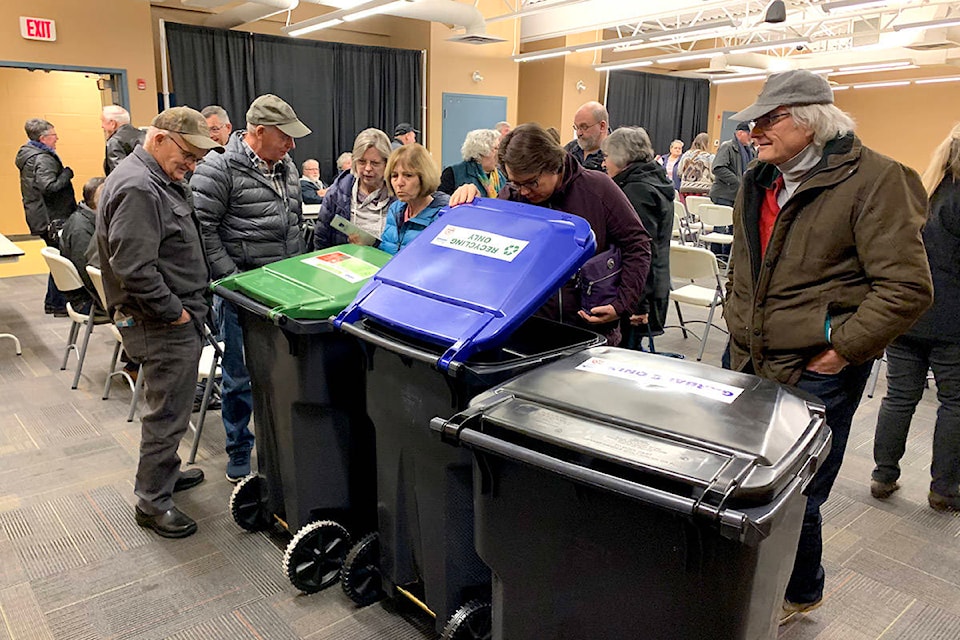The district is revising its solid waste bylaw, with wording that involves changes in behaviour of residents as well as fines for illegal dumping and leaving wildlife attractants out.
Mayor and council reviewed Bylaw 1472 at a Monday, May 11 committee meeting. Among changes to the nearly three decades old bylaw, residents will have stricter hours for when to put out and bring in their carts, as well as more details on how to deal with wildlife issues.
Some parts of the bylaw will need resources to enforce Director of Operations Kevin Dicken said, including the hours carts must be set out and set back. Under section 6, residents have to have their carts set out on their driveways no earlier than 5:30 a.m. and no later than 7 a.m. on collection day. They also have to bring in their carts by 7 p.m. on that same day.
Read more: Full text of Bylaw No. 1472
How a bylaw officer would be able to enforce this is still to be determined, but it could involve switching the officer’s hours around on collection day said Donna Bellingham, Director of Corporate Services.
Under the bylaw, the officer is also allowed to enter any piece of land to check if people are complying. If they are hindered from doing so, a $250 fine is possible.
The district has had two requests for set out and set back service, i.e. bringing the cart from the home to the curb and back again. A person who needs this service can apply to the district at a fee set by Valley Waste, district documents state.
The bylaw also deals with wildlife in a number of ways. Under the bylaw, residents have to keep their garbage and green waste in “wildlife resistant enclosures” such as a shed or garage or make the carts wildlife resistant.
As councillor Scott Medlock observed, there has been some chatter online about issues with the bins. “Of course they’re not animal-proof, they’re simply resistant. That’s basically the best we can do in this situation,” he said, adding education is an ongoing need and if education isn’t enough, fines might be necessary.
Lydia Koot, who runs education and advocacy with the Hope Mountain Black Bear Committee, has previously told The Hope Standard that bears can still get into these containers. “What the bears do is they dump them to the side, they slap on the bin and the lid just jumps open, or they just rip the lid open,” she explained. Koot said she’s heard of at least five instances of bears opening the bins.
Read more: Keep your garbage locked up, advocates urge, as bears come out
An added hurdle is where to store the bins, Koot said, as many who live in smaller homes or trailer parks do not have a space to store them inside.
For people who have repeat issues with wildlife and their waste containers, they could be required to purchase an additional latch Dicken said. Some residents in areas where there is a high chance of wildlife interaction may also have to build wildlife resistant structures - i.e. a shed or garage - to store waste under the bylaw. “That would be in areas where there’s high wildlife interaction, I don’t envision that everybody would need to do this,” Dicken said.
Residents also cannot keep any ‘attractant’ on their property. Attractants are defined in the bylaw as “any substance which could reasonably be expected to attract wildlife…including but not limited to garbage, organics, beverage containers, barbecue grills, pet food, bird feed, diapers, grease barrels, fruit, salt, oil and other petroleum products and chemical products.”
Detailed instructions are given in the bylaw on removing fruit from trees, keeping bird feeders and bee hives inaccessible to wildlife and making sure attractants aren’t included in people’s own compost systems. A $250 fine can be given if the requirements around attractants aren’t adhered to.
There is also new language about the transfer station, a facility that didn’t exist when the last bylaw was written. It includes a $500 fine if someone is found dumping items not allowed such as septic tank waste, animal carcasses or explosive substances. “That might seem pretty steep, but if somebody dumps for example like asbestos-containing drywall, that can be very costly for us to dispose of properly,” Dicken said.
And people who would want to salvage items from the transfer station are out of luck - this activity carries a $100 fine.
The bylaw also includes a $100 fine for ‘(scavenging) solid waste’ from carts or containers for glass recycling. Councillor Bob Erickson raised concerns that people who are trying to secure some extra income by gathering and recycling containers would be penalized.
The idea is not to “drive around and fine people that are recycling returnables from carts,” Dicken said, rather it’s about “using common sense” when applying the bylaw and having “a tool in the toolbox” should there be an issue with scavenging.
When it comes to businesses, Dicken said he is still working with Valley Waste on rolling out organics containers to them.
Council will do three readings and adopt changes to the waste bylaw at a council meeting Monday, May 25 at 7 p.m. Due to COVID-19 measures, meetings are closed to the public and are instead being conducted via livestream on the district’s Facebook page.
Residents can still get in touch with councillors at this time and can also email dbellingham@hope.ca with questions or comments.
emelie.peacock@hopestandard.com
Like us on Facebook and follow us on Twitter
